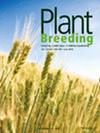在埃塞俄比亚西北部自然感染条件下精英春面包小麦(Triticum aestivum L.)基因型对三尖杉败酱病的田间反应和遗传变异性
IF 1.8
4区 农林科学
Q2 AGRONOMY
引用次数: 0
摘要
真菌病害对小麦生产造成重大减产。由子囊菌 Zymoseptoria trtici 引起的 Septoria tritici blotch(STB)是影响全球小麦生产的主要真菌病害之一。在埃塞俄比亚,STB 是高海拔和中海拔小麦种植区的一个严重问题,会造成重大减产。使用抗病品种是可持续的病害管理策略之一,对于发展中国家资源匮乏的农民来说尤其如此。在两个 STB 热点环境的自然侵染条件下,采用阿尔法网格设计对 250 个面包小麦基因型进行了评估,以确定抗三尖杉败酱病的基因型,并估计抗 STB 和其他重要经济性状的遗传变异程度。方差分析显示,在所有测定的性状上,基因型之间、环境之间以及基因型 × 环境交互作用之间都存在非常显著的差异。所有研究性状的遗传变异系数均低于表型变异系数,两种试验环境均显示出环境对性状表达的影响。败酱病严重程度参数的遗传力值较高且中等,表明 STB 抗性性状受环境影响较小。打顶天数和株高与病害严重程度成反比。这表明植株高、成熟期长的基因型可通过逃逸机制抵抗三尖杉败酱病。其中四个基因型,即 G-215、G-255、G-257 和 G-258,在所有地点都具有抗病性。这些基因型和其他有希望的基因型将用于未来的育种计划,以选育或开发高产、抗STB的面包小麦基因型,并将其应用于败酱病斑病多发地区。高易感基因型也将作为抗 STB 育种计划的对照。本文章由计算机程序翻译,如有差异,请以英文原文为准。
Field response and genetic variability of elite spring bread wheat (Triticum aestivum L.) genotypes for septoria tritici blotch under natural infection in Northwest Ethiopia
Fungal diseases cause significant yield loss to wheat production. Septoria tritici blotch (STB), caused by the ascomycete fungus Zymoseptoria trtici , is one of the major fungal diseases affecting wheat production worldwide. In Ethiopia, STB is a severe problem that causes significant yield loss in high and mid‐altitude wheat‐growing areas. The use of resistant varieties is one of the sustainable disease management strategies, particularly for resource‐poor farmers in developing countries. Two hundred and fifty bread wheat genotypes were evaluated to identify septoria tritici resistant genotypes and estimate the extent of genetic variability for resistance to STB and other economically important traits using alpha lattice design under natural infestation in two STB hotspot environments. Analysis of variance revealed highly significant differences among genotypes, environment, and genotype × environment interaction for all traits measured. The genetic coefficient of variance was lower than the phenotypic coefficient of variance for all traits studied, and both test environments showed the influence of the environment on trait expression. High and moderate heritability values were observed for the septoria disease severity parameters, indicating that the STB resistance trait was less influenced by the environment. The days to heading and plant height were inversely correlated with disease severity. This suggests that genotypes with tall plant height and long maturity period could be resistant to septoria tritici blotch through escape mechanisms. Four of the genotypes, namely, G‐215, G‐255, G‐257, and G‐258, were found to be resistant across all locations. These and other promising genotypes will be used in future breeding programmes to select or develop high‐yielding and STB‐resistant bread wheat genotypes that can be deployed in septoria tritici blotch‐prone areas. Highly susceptible genotypes will also be used as controls for STB resistance breeding programmes.
求助全文
通过发布文献求助,成功后即可免费获取论文全文。
去求助
来源期刊

Plant Breeding
农林科学-农艺学
CiteScore
4.40
自引率
5.00%
发文量
74
审稿时长
3.0 months
期刊介绍:
PLANT BREEDING publishes full-length original manuscripts and review articles on all aspects of plant improvement, breeding methodologies, and genetics to include qualitative and quantitative inheritance and genomics of major crop species. PLANT BREEDING provides readers with cutting-edge information on use of molecular techniques and genomics as they relate to improving gain from selection. Since its subject matter embraces all aspects of crop improvement, its content is sought after by both industry and academia. Fields of interest: Genetics of cultivated plants as well as research in practical plant breeding.
 求助内容:
求助内容: 应助结果提醒方式:
应助结果提醒方式:


